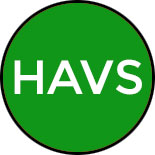Hand Arm Vibration
Hand-arm vibration is vibration transmitted from work processes into workers' hands and arms. This can be any form of vibration, from that generated through hand-held power tools, to that generated from holding materials being processed by machines.
Whilst occasional exposure is unlikely to cause ill health, regular and frequent exposure to hand-arm vibration can lead to permanent health effects. Hand-arm vibration can cause a range of conditions collectively known as hand-arm vibration syndrome (HAVS), as well as specific diseases such as carpal tunnel syndrome.
- HAVS is preventable, but once the damage is done it is permanent.
- HAVS is serious and disabling, and nearly 2 million people are at risk.
- Damage from HAVS can include the inability to do fine work and cold can trigger painful finger blanching attacks.
The construction industry is an industry where, because of the extensive use of heavy duty hand held power tools and hand operated equipment, exposures to vibration are particularly high,.
Tthe Control of Vibration at Work Regulations 2005, place obligations on all employers to assess and identify measures to eliminate or reduce risks from exposure to hand-arm vibration. Those regulations also impose two limits to exposure which must be adhered to
- The exposure action value (EAV) which is the daily amount of vibration exposure above which employers are required to take action to control exposure. The greater the exposure level, the greater the risk and the more action employers will need to take to reduce the risk. For hand-arm vibration the EAV is a daily exposure of 2.5 m/s2 A(8).
- The exposure limit value (ELV) which is the maximum amount of vibration an employee may be exposed to on any single day. For hand-arm vibration the ELV is a daily exposure of 5 m/s2 A(8). It represents a high risk above which employees should not be exposed.
To estimate a worker’s daily vibration exposure you will need two pieces of Information,
- The vibration emission value. This is the value quoted which represents the average vibration magnitude at the hand position on the tool, handle, workpiece etc. This is expressed as an acceleration value in metres per second squared (m/s2); and
- The daily exposure time. This is the time for which an employee’s hand is actually in contact with that vibration. This is not the overall time spent on the job, but the ‘contact time’ or ‘trigger time’ (often much shorter) for which the operator’s hands are actually exposed to the vibration.
A person’s daily vibration exposure is, like the vibration magnitude, expressed in acceleration units of m/s2. The daily exposure can be thought of as the average vibration spread over a standard working day of eight hours, adjusted to take account of the actual total exposure time (ie contact time or trigger time). To avoid confusion with vibration magnitudes, it is conventional to add ‘A(8)’ after the units when quoting a daily vibration exposure, for example: ‘5 m/s2A(8)’.
The HSE has also produced a calculator to assist in calculating exposures for hand-arm vibration that can be downloaded from the HSE website. The link to the relevant page is as follows.
http://www.hse.gov.uk/vibration/hav/vibrationcalc.htm
Exposure Points System
An alternative method, and one which is simpler to use is the exposure points system.
By using the the table below the exposures for different combinations of vibration magnitude and exposure time are given in exposure points instead of values in m/s2 A(8).
- exposure points change simply with time: twice the exposure time, twice the number of points;
- exposure points can be added together, for example where a worker is exposed to two or more different sources of vibration in a day simply add the points together;
The relevant values in points are as follows.
- the exposure action value (EAV - 2.5 m/s2 A(8)) is equal to 100 points;
- the exposure limit value (ELV - 5 m/s2 A(8)) is equal to 400 points;

The colour of the square containing the exposure points value tells you whether the exposure exceeds, or is likely to exceed, the exposure action or limit value:

Using the ready reckoner
- Find the vibration magnitude (level) for the tool or process (or the nearest value) on the grey scale on the left of the table.
- Find the exposure time (or the nearest value) on the grey scale across the bottom of the table.
- Find the value in the table that lines up with the magnitude and time.
- Compare the points value with the exposure action and limit values (100 and 400 points respectively).
- If a worker is exposed to more than one tool or process during the day, repeat steps 1 – 3 for each one, add the points, and compare the total with the exposure action value (100) and the exposure limit value (400).
Management of the Risk
As is always the case where there is a risk the first consideration should be whether there is an alternative process to avoid or reduce the use of vibrating equipment.
Where that process is unavoidable the HAV risks should be properly managed by:
- Selecting suitable work equipment.
- Limiting daily exposure
- Providing Information, instruction and training.
- Health surveillance
- Other risk control considerations
Selecting suitable work equipment .
In this regard you should assess vibration emission values, safety, size, power, efficiency, ergonomics, and user acceptability, etc.
It may not always be essential or desirable to choose the tool with the lowest declared vibration emission. The machine also be safe and suitable for the particular task. Furthermore the overall exposure may be lower when using a machine with a higher emission value because it does the job quicker. In general the HSE advice is that you should aim to avoid tools with significantly above average vibration emission.
Other factors that will increase vibration are
- Blunt cutting tools
- Equipment that is poorly maintained or which has developed a fault.
Providing Information, instruction and training.
The Regulations require that information on vibration emissions must be provided in instructions accompanying hand-held and hand-guided machinery. The main information which must be supplied is:
- the weighted root-mean-square (rms) acceleration value (ie vibration emission) to which the arms are subjected where this exceeds 2.5 m/s2 when determined by the appropriate test code (or the fact that it does not exceed 2.5 m/s2 where this is the case);
- any measures needed to keep residual risks from vibration under control when the machine is used. For example:
- if periodic inspection and replacement of \any anti-vibration mounts on the handles is required, this should be mentioned in the maintenance instructions;
- if the type of inserted tool or consumable (eg grinding disc, blade chisel or drill bit) affects the vibration emission, this should be mentioned in the instructions;
- if the vibration emission of a breaker with vibration-isolating handles is dependent on the force applied by the user, advice on the training of operators should be supplied with the machine.
Good general training will include advising the operator to
- Using the tool at the correct height and in the correct position
- Avoiding gripping or forcing a tool more than they have to.
- Encouraging good blood circulation by keeping warm and dry
- Storing tools so that they do not have very cold handles when next used.
Other risk control considerations
- Ergonomic aids to support weight of tool or reduce forces applied by operator,
- Maintaining a suitable workplace temperature or providing warm clothing and gloves,
- Allowing regular breaks from vibration and encouraging operators to exercise fingers
Product Catalogue Guidance
As a broad guide we use the following symbols in our product catalogue to indicate the HAVS risk for each of our products.
 |
Hand Arm Vibration (Low Risk) | This signifies that the equipment has a HAV rating of 5 m/s2 or less. Where additional HAV symbols are shown this signifies that the equipment has alternative settings and this symbol represents the value at the lowest setting. As a broad guide, at this level, equipment with this or a similar rating can be used for an 8 hour day without exceeding the statutory limits. Any usage of equipment with a medium or high rating would however reduce this limit. |
 |
Hand Arm Vibration (Med Risk) | This signifies that the equipment has a HAV rating of between 5 m/s2 and 10m/s2. Where additional HAV symbols are shown this signifies that the equipment has alternative settings and this symbol represents the value of either the alternative or the lowest setting. As a broad guide, at this level, equipment with this or a similar rating should not be used for more than 2 hours per working day, and less where equipment within the other risk bands have also been used. |
 |
Hand Arm Vibration (High Risk) | This signifies that the equipment has a HAV rating of over 10m/s2. Where additional HAV symbols are shown this signifies that the equipment has alternative settings and this symbol represents the value of the alternative or highest setting. As a broad guide, when using this type of equipment the operator is extremely likely to reach or exceed the statutory limits. |
What are the early symptoms?
Identifying signs and symptoms at an early stage is important. The symptoms include any combination of:
- Tingling and numbness in the fingers;
- Not being able to feel things properly;
- Loss of strength in the hands;
- Fingers going white (blanching) and becoming red and painful on recovery (particularly in the cold and wet, and probably only in the tips at first).
For some people, symptoms may appear after only a few months of exposure, but for others they may take a few years. They are likely to get worse with continued exposure to vibration and may become permanent.
It is the users responsibility to:
- To assess and reduce any exposure to vibration prior to commencing any work.
- To select the appropriate equipment for the task
- To check the equipment and accessories prior to use.
- To ensure that any usage is within the limits or rules of the regulations.
As the supplier of equipment for use on site it is Togas responsibility to
- Ensure that our equipment is maintained and is not producing excess vibration
- That the customer is advised of the vibration emission value applicable to that machine
CONTAINS PUBLIC SECTOR INFORMATION PUBLISHED BY THE HEALTH AND SAFETY EXECUTIVE AND LICENSED UNDER THE OPEN GOVERNMENT LICENCE V1.0’.
HSE website links.
http://www.hse.gov.uk/construction/healthtopics/vibration.htm
http://www.hse.gov.uk/vibration/hav/vibrationcalc.htm
http://www.hse.gov.uk/vibration/hav/readyreckoner.htm
http://www.hse.gov.uk/vibration/hav/advicetoemployers/vibration-exposure-monitoring-qa.pdf
http://www.nationalarchives.gov.uk/doc/open-government-licence/
Want to know more?
Call us today on 020 8533 5222
At TOGA Hire Centres, we take Health and Safety matters very seriously and hope that these fact sheets are of help. However, we must stress that these guidelines are not intended to be fully comprehensive instructions and the customer should, of course, be aware that it is their responsibility to ensure the health and safety of their staff at all times.
More TOGA Hire Health & Safety

PPE & Safety Symbols
Throughout the product catalogue pages, you’ll find safety symbols designed to act as a guide to the safe operation of our hire equipment. For an explanation of those safety symbols please see the table below. More Details

Equipment Testing
If your business or organisation provides or uses work equipment then you are under an obligation to ensure that any such equipment is safe to use and that any risks from that equipment to employees or other third parties are properly managed. More Details

Working at Height
According to RIDDOR falls from height accounted for nearly a quarter of all fatal injuries to workers in 2011/12. Of the all the industry classifications, construction reported the most injuries (fatal and non fatal) resulting from falls. More Details

Dust Control
Recent HSE research has estimated that silica may be responsible for the deaths of over 500 people each year who have worked in construction. HSE also estimates that around 4,000 people die every year from Chronic obstructive pulmonary disease (COPD). More Details

Noise
Regular, frequent exposure to high noise levels causes deafness or tinnitus (permanent ringing in the ears). Hearing loss can be either temporary or permanent, but what is known is that the longer the exposure and the higher the noise level, the greater More Details

Lifting
Any business or organisation that undertakes lifting operations or is involved in providing lifting equipment for others to use, must manage and control the risks to avoid any injury or damage. More Details

OUR ENVIRONMENTAL COMMITMENT
TOGA Plant Hire is committed to keeping up with current legislative requirements and best practice. More Details

Insurance Cover
Rest assured that when dealing with TOGA, you are dealing with a company that has full and proper insurance in place. More Details